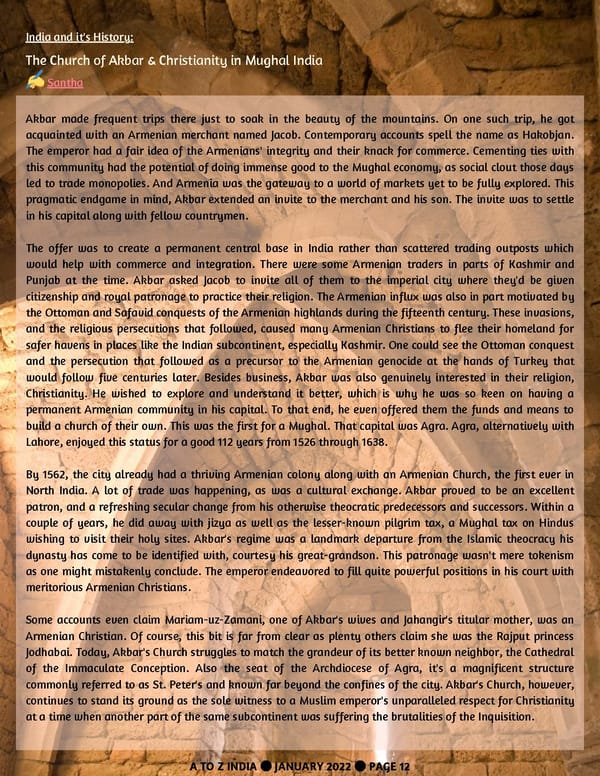Akbar made frequent trips there just to soak in the beauty of the mountains. On one such trip, he got acquainted with an Armenian merchant named Jacob. Contemporary accounts spell the name as Hakobjan. The emperor had a fair idea of the Armenians' integrity and their knack for commerce. Cementing ties with this community had the potential of doing immense good to the Mughal economy, as social clout those days led to trade monopolies. And Armenia was the gateway to a world of markets yet to be fully explored. This pragmatic endgame in mind, Akbar extended an invite to the merchant and his son. The invite was to settle in his capital along with fellow countrymen. The offer was to create a permanent central base in India rather than scattered trading outposts which would help with commerce and integration. There were some Armenian traders in parts of Kashmir and Punjab at the time. Akbar asked Jacob to invite all of them to the imperial city where they'd be given citizenship and royal patronage to practice their religion. The Armenian influx was also in part motivated by the Ottoman and Safavid conquests of the Armenian highlands during the fifteenth century. These invasions, and the religious persecutions that followed, caused many Armenian Christians to flee their homeland for safer havens in places like the Indian subcontinent, especially Kashmir. One could see the Ottoman conquest and the persecution that followed as a precursor to the Armenian genocide at the hands of Turkey that would follow five centuries later. Besides business, Akbar was also genuinely interested in their religion, Christianity. He wished to explore and understand it better, which is why he was so keen on having a permanent Armenian community in his capital. To that end, he even offered them the funds and means to build a church of their own. This was the first for a Mughal. That capital was Agra. Agra, alternatively with Lahore, enjoyed this status for a good 112 years from 1526 through 1638. By 1562, the city already had a thriving Armenian colony along with an Armenian Church, the first ever in North India. A lot of trade was happening, as was a cultural exchange. Akbar proved to be an excellent patron, and a refreshing secular change from his otherwise theocratic predecessors and successors. Within a couple of years, he did away with jizya as well as the lesser-known pilgrim tax, a Mughal tax on Hindus wishing to visit their holy sites. Akbar's regime was a landmark departure from the Islamic theocracy his dynasty has come to be identified with, courtesy his great-grandson. This patronage wasn't mere tokenism as one might mistakenly conclude. The emperor endeavored to fill quite powerful positions in his court with meritorious Armenian Christians. Some accounts even claim Mariam-uz-Zamani, one of Akbar's wives and Jahangir's titular mother, was an Armenian Christian. Of course, this bit is far from clear as plenty others claim she was the Rajput princess Jodhabai. Today, Akbar's Church struggles to match the grandeur of its better known neighbor, the Cathedral of the Immaculate Conception. Also the seat of the Archdiocese of Agra, it's a magnificent structure commonly referred to as St. Peter's and known far beyond the confines of the city. Akbar's Church, however, continues to stand its ground as the sole witness to a Muslim emperor's unparalleled respect for Christianity at a time when another part of the same subcontinent was suffering the brutalities of the Inquisition. The Church of Akbar & Christianity in Mughal India Santha India and it's History: A TO Z INDIA ● JANUARY 2022 ● PAGE 12
 A TO Z INDIA - JANUARY 2022 Page 11 Page 13
A TO Z INDIA - JANUARY 2022 Page 11 Page 13